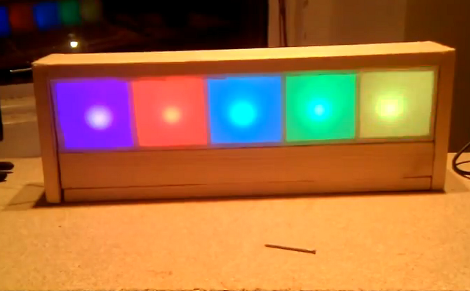
[Martijn] is showing off his new clock which he calls a Light Spectrum Clock. We like to look of it, using RGB LEDs in five squares that remind us of some of those LED coffee table builds. From left to right this shows the week, day, hour, minute, and second. Simple, right?
We had to smile a little bit when looking through his write up. He chose an Arduino nano as a controller, using a TLC5940 chip to drive the LEDs. But it is the inclusion of a DS1307 real-time clock that we find amusing. It will keep quite accurate time (not quite as well as the DS3232 but still respectable) but the fuzzy display technique makes telling the time accurately an impossibility. But like other color-based clocks, that’s part of the fun. The real reason for using an RTC chip is that they usually include battery-backed operation so that you can shut off the LEDs when you’re not around and the clock will continue to tick.
You can watch the seconds pass by as fading colors in the clip after the break.
[youtube=http://www.youtube.com/watch?v=C92FkK1RlwM&w=470]
















Interesting. I find this very difficult to read, but perhaps a grayscale clock would not be so bad. Imagine four grayscale e-ink squares, the leftmost changes throughout the entire day, the next one does two cycles per day, third does four cycles, and fifth does eight cycles. Maybe?
The title made me think it had something to do with Heisenberg’s uncertainty principle.
Still a nice hack :)
Well after reading the description I’m sure it works, I have no friggin’ idea what time it is by this thing!
You would have to have a card with reference colors for each week/day/hour/minute/second. Kind of like water testing kits that change color. Hold the card up to the clock to tell the time.
cool, great finish
but personally i think having the date be a backround color of some sort lighting up the wall behind it and the clock digits should be HH.MM.SS. and not H.M.S. would make it eaiser to read
personally i think ud be able to tell time better if there were the normal 5 + 1/2 digits instead of 3
now i wanna make one
Another reason to use a DS1307 (or other RTC) is that it’s simpeler to make a low-drift clock doing that on microcontroller timers. So the readout may be a bit hazy, at least the time drifts less over days / months. Which might be very handy especially with such a ‘vague’ readout.
Now build a wrist-mounted chroma meter to read the clock and display the time!
The desingn looks awesome :)
I do think that a display showing HH:MM with some 10 colors per digit would be better as reading possibility. Of course, with smooth crossing between colors.
@everyone: Don’t confuse resolution with accuracy.
Resolution is how precise you can read it, say 15 minutes. Accuracy is how well the clock keeps track of time. If the clock was inaccurate, say move away 1 minute per day it will become useless and inaccurate in a few days/weeks, which has nothing to do with the ability to tell the rime precisely.
[insert seizure disclaimer here]